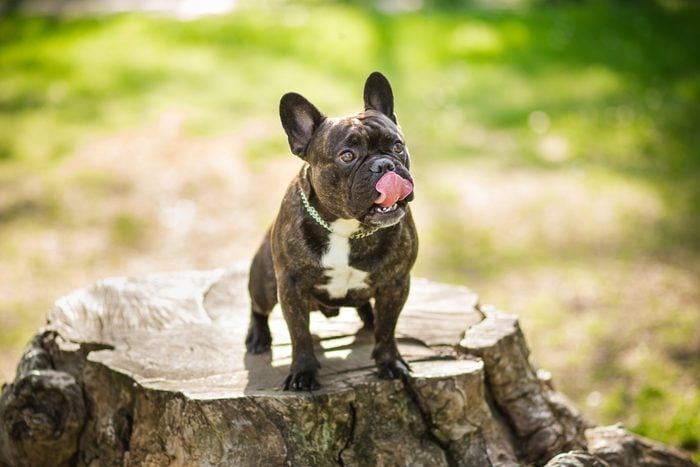
Très bone
When you think of French dogs, you probably think of poodles first, but did you know they’re not really French? The Frenchest of all dogs is actually from Germany. Its name, poodle, comes from the German pudel, meaning to splash. It was popularized as a society and circus dog in France, so we include it here as an honorary Frenchie! The curly-haired poodle was one of the most popular breeds in the United States for years, but now the most popular breed is another Frenchman, the French Bulldog.
And here’s a surprise: Not all French dogs are lap dogs bred for the court at Versailles or for sitting quietly under the table at a Parisian sidewalk café. There are French dogs used for hunting, herding, sailing and other tasks, and they come in all sizes—even giant dog breeds. And for the right owner, they make delightful pets. Here are 15 of our favorite French dog breeds just waiting for you to say “oui.”
Get Reader’s Digest’s Read Up newsletter for more pets, cleaning, humor, travel, tech and fun facts all week long.
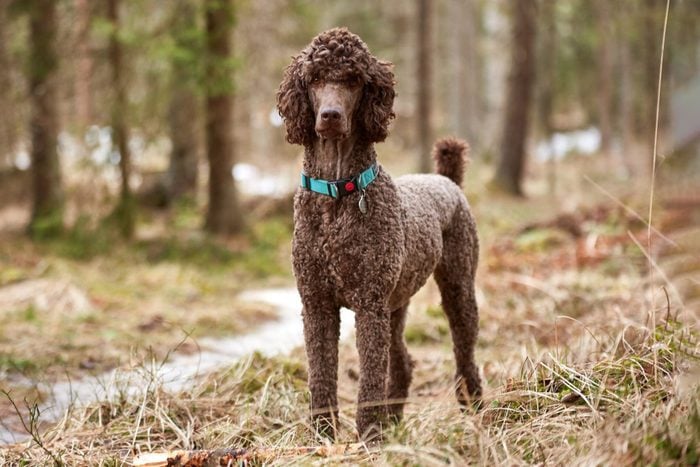
Poodle
Standard, miniature or toy, the poodle has been one of the most popular dog breeds in the United States since the 1960s and consistently ranks among the top ten most beloved breeds. But here’s some poodle trivia: The official dog of France actually originated in Germany, though it was French nobility who took a special interest in the breed. They were originally bred as duck hunters, and today poodles still do best when they have a job to do. These alert, super-smart dogs take well to training and need to be engaged in activities; leave them to their own devices, and they can get destructive. Poodles have hair, not fur, so while they require regular grooming, they may make great pets for some people with allergies. Smaller sizes tend to live longer.
| Breed Overview | |
| Height: | 10 inches or less (toy), 10 to 15 inches (miniature), 15 inches and up (standard) |
| Weight: | 4 to 6 pounds (toy), 10 to 15 pounds (miniature), 40 to 70 pounds (standard) |
| Life expectancy: | 10 to 18 years |
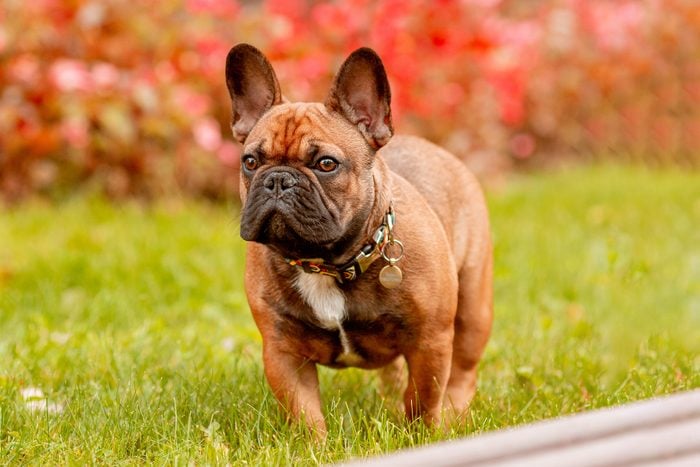
French bulldog
Move over, poodles. There’s a new dog on the block. In a 2022 American Kennel Club (AKC) survey of the most popular dog breeds in the United States, French bulldogs ranked No. 1, while poodles came in fifth place. And like poodles, the Frenchie is a transplant—the breed originated in England and was imported to France in the 1800s, where it became one of the most popular French dogs. Frenchies are loved for their friendly, playful temperament, and they’re great with kids. Since they don’t need a lot of exercise, they’re also great apartment dogs, though they might suffer from some separation anxiety if left alone for too long. You also need to watch for health issues with these sweet pups, especially respiratory disorders and conditions associated with overheating.
| Breed Overview | |
| Height: | 11 to 13 inches |
| Weight: | Under 28 pounds |
| Life expectancy: | 10 to 12 years |
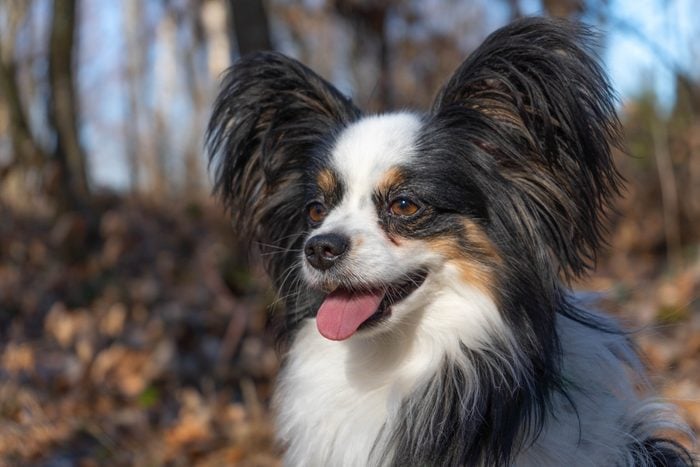
Papillon
You might say that the papillon is all ears—it sure looks that way, at least. Its large, erect ears have cascading tufts of fur, so it’s easy to see where the toy breed got its name: In French, “papillon” means butterfly. This is another one of the French dog breeds with somewhat murky origins, though papillons were regulars in the French court since at least the 1600s. Marie Antoinette is even said to have walked to the guillotine clutching her pet papillon. (Don’t worry. The dog’s life was spared.) Smart and active papillons need a lot of attention and distraction, whether from learning to do tricks, obeying commands, or simply fetching a ball. They’re also low shedders and, other than regular brushing, don’t need much in terms of grooming.
| Breed Overview | |
| Height: | 8 to 11 inches |
| Weight: | 5 to 10 pounds |
| Life expectancy: | 14 to 16 years |
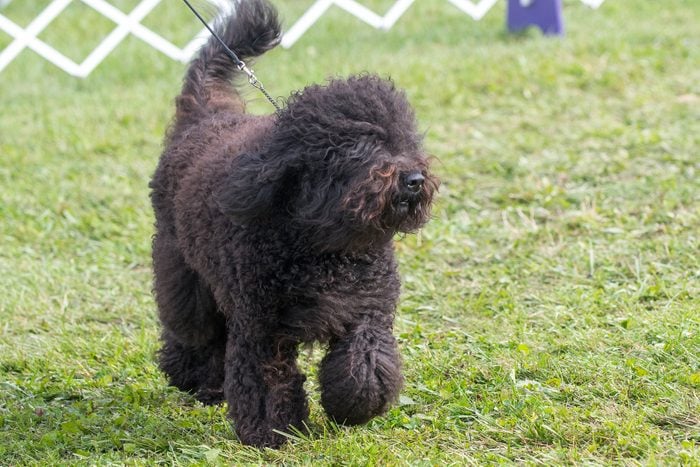
Barbet
The barbet is a rare breed indeed: There are only about 600 of this webbed-foot French water dog in the world. Bred as duck hunters and companion dogs, barbets may date back to the 700s BCE and, as such, are considered one of the oldest dog breeds. Barbets are about the size of a standard poodle, and with their thick fur coats, they look a little like the poodle’s unkempt cousin. That coat requires regular brushing and combing, though barbets don’t shed much. This French dog breed also needs regular exercise and tasks to perform, and it especially loves retrieving a stick or toy from the water. If you have a swimming pool, you’ll likely have one very happy barbet. They’re good with children and other dogs, too.
| Breed Overview | |
| Height: | 19 to 24.5 inches |
| Weight: | 35 to 65 pounds |
| Life expectancy: | 12 to 14 years |
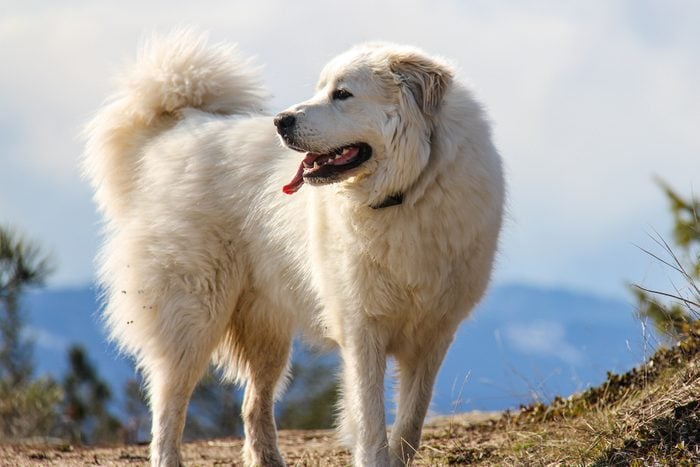
Great Pyrenees
Also called the Pyrenean mountain dog, this gentle giant is a close relative of the Maremma sheepdog, one of our favorite Italian dog breeds. Raised in the Pyrenees mountains that straddle France and Spain, the breed was long used for the protection of sheep from hungry wolves and bears. Today, the Great Pyrenees is still used as a guardian of flocks in France and Spain, though most Pyrenees lead lives of leisure. They don’t need a whole lot of exercise, but because of their size—they can weigh more than 100 pounds—they’re not suited for apartment living. Great Pyrenees make affectionate family pets, though their predisposition to serving as guard dogs may make them somewhat wary of strangers. These big, white fur balls shed routinely and “blow” their coats once a year.
| Breed Overview | |
| Height: | 25 to 32 inches |
| Weight: | 85 pounds and up |
| Life expectancy: | 10 to 12 years |
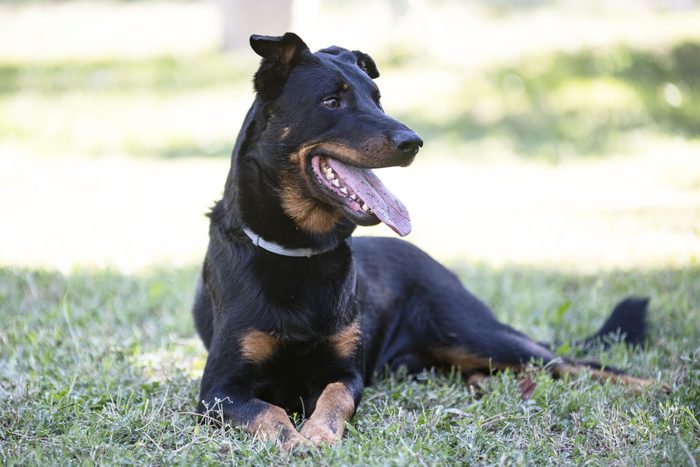
Beauceron
If the Beauceron looks a little like a more robust Doberman, that’s no accident. These French dogs are predecessors of the Doberman and have similarly been used as protectors of livestock and property and as working dogs in times of war. It gets its other names, Berger de Beauce and Bas Rouge (red stockings), from its distinctive red paws and lower legs. Beaucerons also have another defining feature: double dewclaws with two “thumbs” on each hindfoot. Despite their short, smooth coats, they do shed regularly, so brushing with a hand mitt or similar item is recommended. These loyal, strong-willed dogs are best for experienced dog owners. Gentle obedience training will help curb bad habits, such as jumping and mouthiness.
| Breed Overview | |
| Height: | 24 to 27.5 inches |
| Weight: | 70 to 110 pounds |
| Life expectancy: | 10 to 12 years |
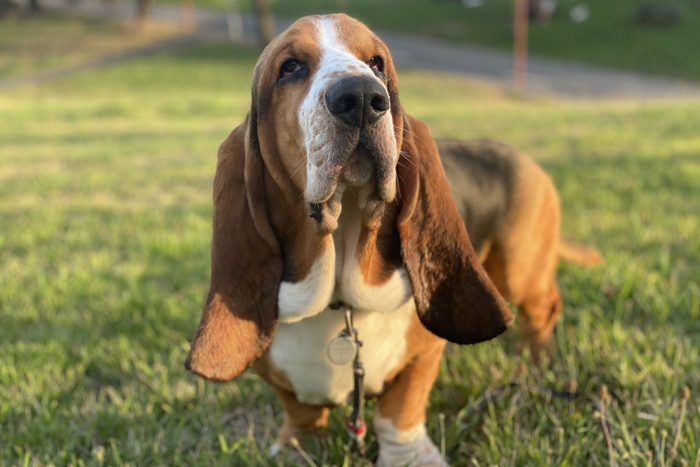
Basset hound
Would you have guessed that the basset hound is a French dog breed? We didn’t! But this droopy-eyed, floppy-eared, jowly breed was developed in France, though it likely originated in ancient Greece. Traditionally used for hunting rabbits, the basset’s extra-sensitive nose and short legs make it a top choice for tracking, whether it’s on the hunt for a missing child or a criminal at large. They’re also wonderfully docile with children and enjoy a good walk or play session. They shouldn’t be allowed to wander off-leash, though, because if they pick up a scent, they won’t stop until they get to the source! This unique breed is prone to eye infections, and its ears need to be cleaned regularly.
| Breed Overview | |
| Height: | Up to 15 inches |
| Weight: | 40 to 65 pounds |
| Life expectancy: | 12 to 13 years |
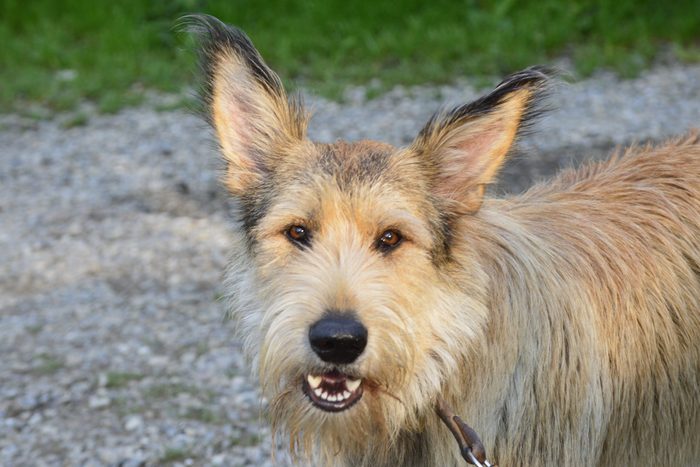
Berger Picard
A herding dog from northern France, the Berger Picard fell on hard times during both world wars, when the breed nearly went extinct. It’s still relatively rare, with only a few hundred of the French dogs in the United States, according to the AKC. Also called the Picardy shepherd, it has been in France since at least the first millennium and is considered the oldest breed of French sheepdogs. Today, they are increasingly popular family dogs that require human company and regular physical activity. This breed also has an independent streak that is best tempered with early socialization and lots of affection. Their wiry coats don’t need much in the way of grooming, though they will shed their undercoat once a year.
| Breed Overview | |
| Height: | 21.5 to 25.5 inches |
| Weight: | 50 to 70 pounds |
| Life expectancy: | 12 to 13 years |
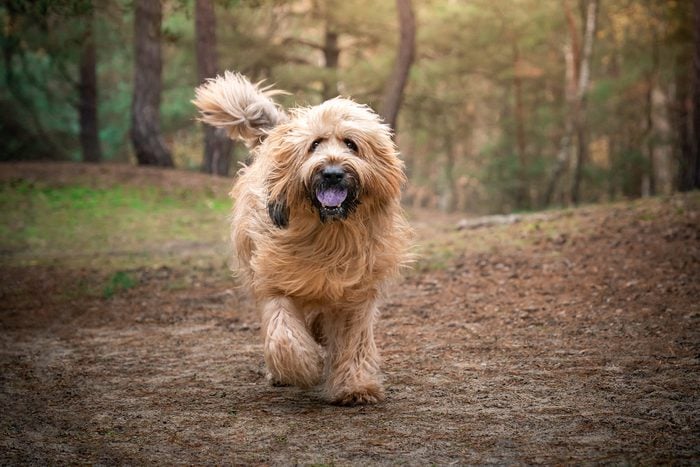
Briard
There’s more to the Brie region of France than just soft, creamy cheese. Berger de Brie, or the briard, is a shagalicious sheepdog that for centuries was used for herding and defending flocks. Briards also saw duty in both world wars, which nearly resulted in the breed’s extinction. Today, they’re known as trusty companion dogs that, while wary with strangers, are loyal to their family and good with children. True to its working-dog roots, the briard needs chores, whether that’s chasing a ball or accompanying you on a hike. It also needs a big, fenced-in yard in which to run off all that excess energy and regular brushing to keep its long coat from matting.
| Breed Overview | |
| Height: | 22 to 27 inches |
| Weight: | 55 to 100 pounds |
| Life expectancy: | 12 years |
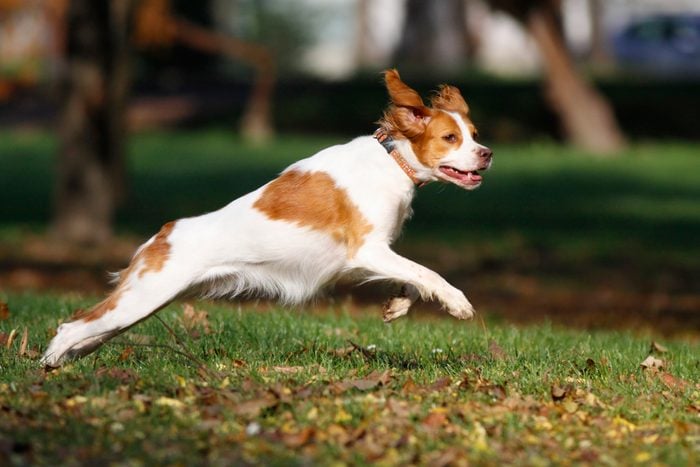
Brittany
With its classic spaniel appearance, it’s easy to see why this breed was once called the Brittany spaniel. But the AKC dropped the “spaniel” part of the name in the 1980s, and now the breed is just the Brittany. Bred as bird dogs in the Brittany region of France, these pups are still popular hunting dogs but are likewise treasured as beloved family pets—for families that have lots of energy, that is. These working dogs need tons of exercise and activities, whether participating in relentless games of fetch or Frisbee or going on energetic walks. Given their bird-hunting instincts, they’re probably not well-suited to homes with pet birds. Their silky coats do well with weekly brushing.
| Breed Overview | |
| Height: | 17.5 to 20.5 inches |
| Weight: | 30 to 40 pounds |
| Life expectancy: | 12 to 14 years |
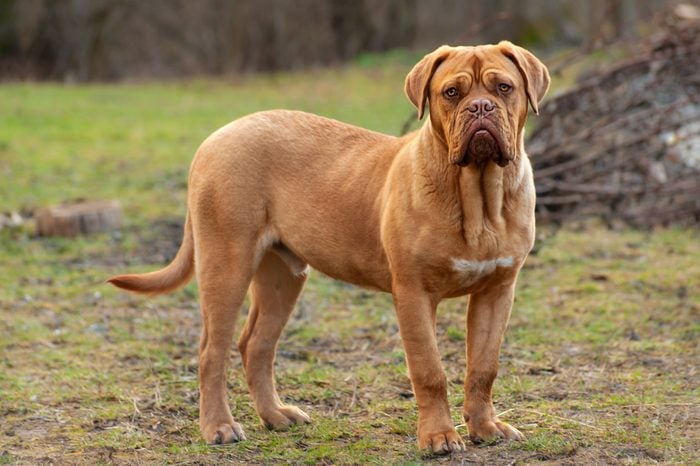
Dogue de Bordeaux
The dogue de Bordeaux doesn’t have a very happy history: It was originally bred by the ancient Romans for use in wars and dogfights. Later, this large, stocky breed was used for hunting, herding and as a guard dog. Today, these powerfully muscular dogs with massive heads are still intimidating, though they’re also regarded as extremely loyal companion dogs who are good with kids. Dogues aren’t for inexperienced dog owners, though, as they’ll walk all over a passive handler. Oh, and they drool—big time. One drawback is their short lifespan; they typically only live for five to eight years.
| Breed Overview | |
| Height: | 23 to 27 inches |
| Weight: | 99 pounds and up |
| Life expectancy: | 5 to 8 years |
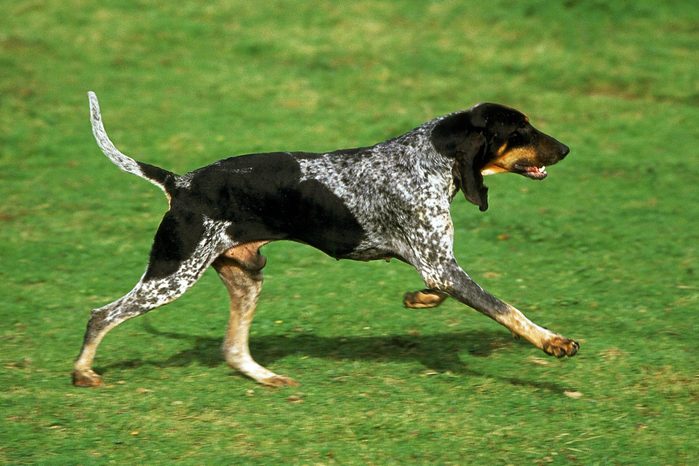
Grand bleu de Gascogne
Long-legged, fleet-footed and always ready for a chase, the grand bleu de Gascogne was bred for hunting deer, wild boar and other large game in the Gascony region of France. These French dogs are still used as hunters in France. They are also reliable companion dogs and do well with other pups (or human family members) that are part of the “pack.” These animals are known for their distinctive howling, so they’re probably not suited for apartments or any place where they’ll be left alone for long periods of time.
| Breed Overview | |
| Height: | 24 to 28 inches |
| Weight: | 70 to 77 pounds |
| Life expectancy: | 10 to 12 years |
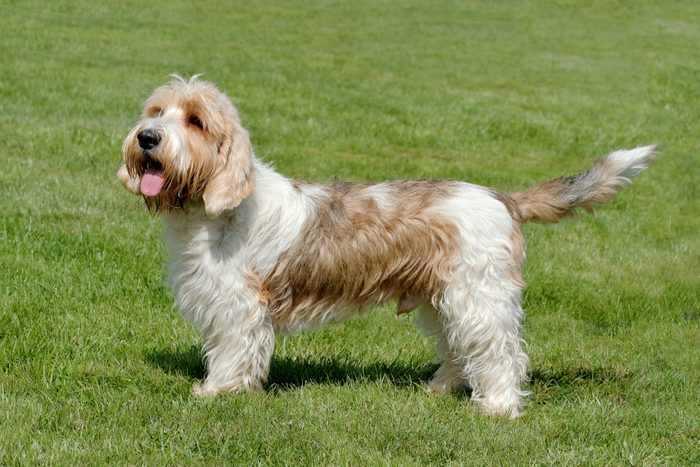
Petit basset griffon Vendéen
Dogs don’t come much more cheerful than the petit basset griffon Vendéen, or PBGV for short. This compact dog bears some similarities to a long-haired dachshund, one of the most popular German dog breeds. Bred to hunt small prey, PBGVs still have a strong prey instinct and are prone to taking off after some particularly interesting scent. But they’ll happily burn up their energy playing ball or exercising with their family members, to whom they are loving and loyal. These are terrific family dogs for households that have a lot of attention to devote to them. PBGVs have wiry coats that require weekly brushing.
| Breed Overview | |
| Height: | 13 to 15 inches |
| Weight: | 25 to 40 pounds |
| Life expectancy: | 14 to 16 years |
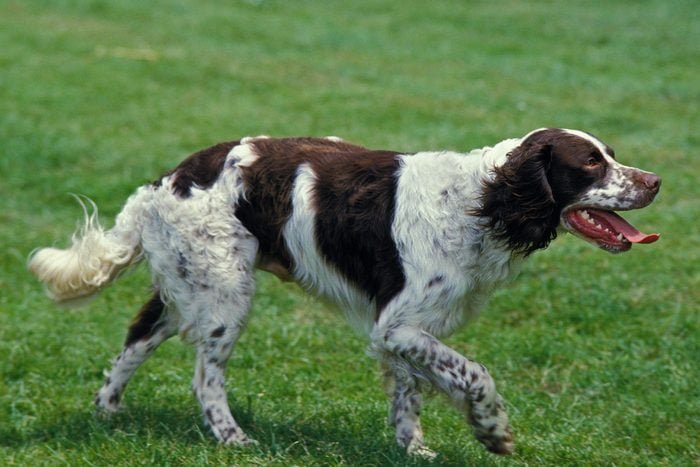
French spaniel
Among French dogs, the French spaniel might be the perfect all-around family dog. Bred for bird hunting, the French spaniel is also a calm and loving companion animal that’s great with children and other dogs. This bundle of energy needs a lot of exercise and, ideally, a fenced-in yard in which to run around. French spaniels are generally quite healthy and have smooth coats that are easy to groom. The breed’s temperament is mellow enough to make it a good choice for first-time dog owners.
| Breed Overview | |
| Height: | 21.5 to 24 inches |
| Weight: | 50 to 60 pounds |
| Life expectancy: | 10 to 12 years |
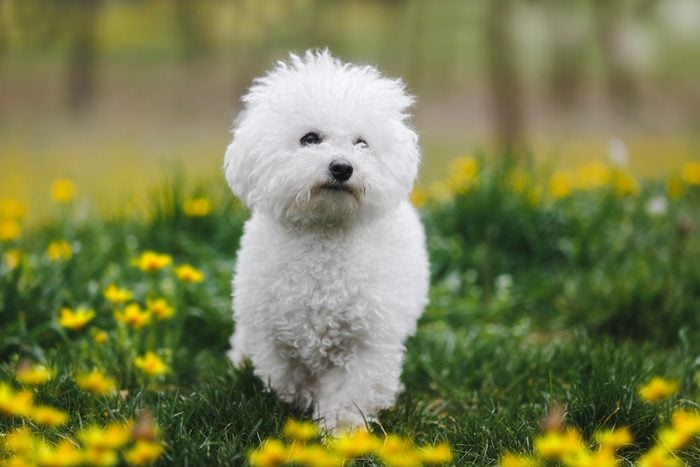
Bichon frisé
We’ll let you in on a secret: The bichon frisé isn’t really a French dog. Instead, its origins probably point to Tenerife, one of Spain’s Canary Islands. Nevertheless, the adorably petite white pup became a favorite of the French court, and its French name stuck. Bichons top many a list of favorite dogs, including best for cuddling, best for people with allergies and best for small apartments. And really, with their warm eyes, button noses and perpetually sweet expressions, there’s a whole lot to love about these little guys. Bichons don’t shed very much, but they do require constant grooming—as in, nearly daily brushing. For families with small children, dogs don’t come much more compatible than bichons.
| Breed Overview | |
| Height: | 9.5 to 11.5 inches |
| Weight: | 12 to 18 pounds |
| Life expectancy: | 14 to 15 years |
Why trust us
At Reader’s Digest, we’re committed to producing high-quality content by writers with expertise and experience in their field in consultation with relevant, qualified experts. For this piece, Elizabeth Heath tapped her experience covering dog behavior and health, and then Caroline Coile, PhD, an award-winning journalist specializing in canine breeds, health and science, gave it a rigorous review to ensure that all information is accurate and offers the best possible advice to readers. We verify all facts and data, back them with credible sourcing and revisit them over time to ensure they remain accurate and up to date. Read more about our team, our contributors and our editorial policies.

